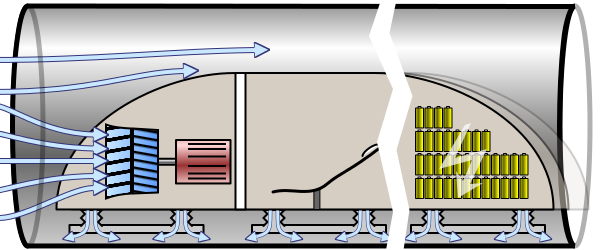Hyperloop: Dropping coins
 The
Hyperloop
is a hypothetical new fast transport system between cities, which works by launching pods that carry people through a very low air pressure tunnel. While riding in the Hyperloop, some coins fall out of your pocket, taking 1/3 of a second to hit the ground. How much more quickly would the coins have hit the ground if you were sitting still
in seconds
?
The
Hyperloop
is a hypothetical new fast transport system between cities, which works by launching pods that carry people through a very low air pressure tunnel. While riding in the Hyperloop, some coins fall out of your pocket, taking 1/3 of a second to hit the ground. How much more quickly would the coins have hit the ground if you were sitting still
in seconds
?
- The radius of the earth is 6 3 7 0 km .
- The Hyperloop travels at 3 0 0 m/s .
- The acceleration of gravity is − 9 . 8 m/s 2 .
Image credit: Wikipedia EuCteUdYq
The answer is 0.00024.
This section requires Javascript.
You are seeing this because something didn't load right. We suggest you, (a) try
refreshing the page, (b) enabling javascript if it is disabled on your browser and,
finally, (c)
loading the
non-javascript version of this page
. We're sorry about the hassle.
2 solutions
When moving in an approximate circle around the Earth, some of the gravity acting on the coin goes to supplying the centripetal force, thus making the "effective gravitational acceleration" less (the same principle applies for why astronauts are weightless aboard the ISS). We know that:
a ′ = g − R v 2
While at rest, the acceleration will simply be a 0 = g . The distance the coins drop is the same. We know that:
d = 2 1 a t 2 ⇒ t = a 2 d
t ′ t 0 = a ′ 2 d a 0 2 d ⇒ t 0 = t ′ a 0 a ′ ⇒ Δ t = t ′ − t 0 = t ′ ( 1 − a 0 a ′ ) = 3 1 ( 1 − a 0 g − R v 2 ) = 3 1 ( 1 − 9 . 8 9 . 8 − 6 3 7 0 0 0 0 3 0 0 2 )
Δ t ≈ 0 . 0 0 0 2 4 s
"The acceleration of gravity is 9.8 m/s/s" means that this is the acceleration when it is stationary. When it is moving, though, some of the gravitational acceleration is centripetal, and only the leftover acceleration is radial.
I will call the time it takes to fall T and I will call the radial acceleration when the Hyperloop is moving a
Since it falls the same (radial) height whether it is moving or not, we know:
9 . 8 T 2 = a ( 3 1 ) 2
And therefore:
T = 3 1 9 . 8 a
As I hinted at before, a is 9.8 minus the centripetal acceleration, which is:
a = 9 . 8 − 6 3 7 0 0 0 0 3 0 0 2
So now you can calculate T , and then take 3 1 − T and you will get the correct answer.